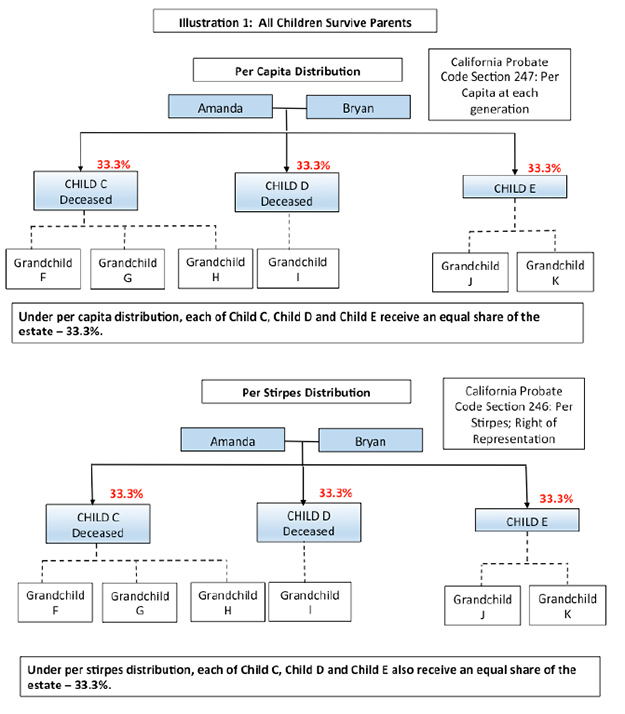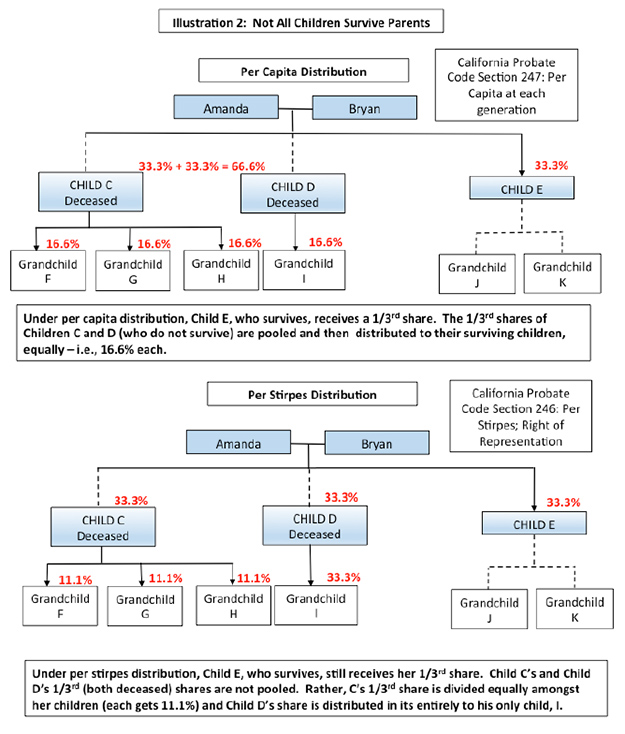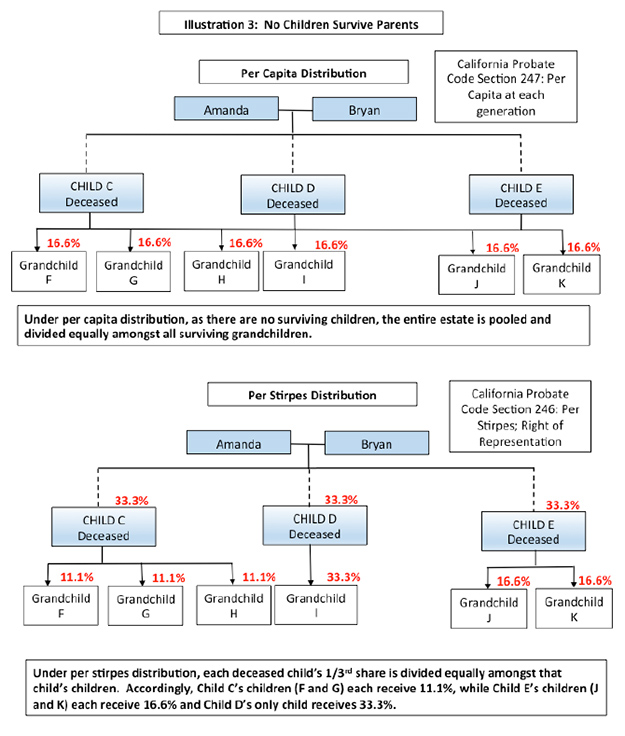June 2016
What Does It All Mean?
Commonly Misunderstood Terminology in Estate Planning
There are many legal terms used in the estate planning context, many of which are confusing to those most affected - the individuals planning for the disposition of their property and those who may (or may not) stand to benefit from such dispositions. This confusion arises not only because some terminology is decidedly "legalese", but also because in the estate planning context some words may have different meanings than expected based on everyday definitions of the underlying words. The following provides an examination of certain commonly misunderstood terms used in the California trust and estate context:
"Heir", "Devisee" and "Beneficiary" are three terms that are frequently misunderstood and often confused with one another. Many people understand these terms to refer to anyone who receives property from a decedent’s estate; however, they do not mean the same thing. Under the California Probate Code, an "heir" is someone who is entitled to take property from decedent’s estate in the event the decedent made no other disposition. In other words, if Amanda dies without a Will or without having established a trust, then her "heirs" would be those to whom the estate would be authorized to distribute assets by a Court in connection with a probate proceeding. These heirs would be determined by degree of relationship to Amanda: her surviving spouse, her children, parents, siblings, cousins, etc.
In the event Amanda does have a Will, her heirs may or may not be entitled to receive property from Amanda’s estate when she dies. In this case, Amanda’s property will be distributed accordingly to her wishes as expressed in her Will. Those whom Amanda designates to receive property are her "devisees" (who may or may not be her heirs). In both cases, Amanda’s heirs and devisees are also referred to as "beneficiaries", as are those who Amanda designates to receive property under any trust she may have established as part of her estate plan.
"Living Will" is another frequently used and frequently misunderstood term. A "living will" is not a disposition of property. Rather, it is a document that sets out the medical treatment that a person wants or doesn’t want to receive in certain situations. In California, a "living will" is included within an "Advance Health Care Directive" - a document which both provides direction as to treatment and appoints a trusted agent to make health care decisions in the event of incapacity.
"Power of Attorney" is yet another misunderstood term, as it has nothing to do with an attorney (other than the one who may have drafted the document). Rather, a Power of Attorney is a document in which an individual appoints an agent, termed an "attorney in fact" to handle his or her financial affairs in the event of incapacity.
In some cases, confusion between terms can lead to unintended consequences. For example, "joint tenancy" and "tenants in common" are two terms are used to describe how two or more individuals hold title to an asset. Both, of course, suggest shared ownership. However, "joint tenancy" provides for a right of survivorship, whereas "tenants in common" does not. This means that Amanda, who owns her residence as a joint tenant with her husband, Bryan, will automatically and immediately, as a matter of law, acquire 100% ownership of the residence upon his death (and vice versa). If Amanda and Bryan owned their residence as "tenants in common", then Amanda would not automatically acquire Bryan’s share. Rather, Bryan’s share would go to his estate. Given these very different results, it is important that co-owners clearly agree upon their intentions and that their ownership documents accurately reflect those intentions by use of the appropriate terminology.
Two other terms that create confusion (and can lead to unintended results) are "per capita" and "per stirpes". The first, "per capita", means the equal distribution, per person, at each generation. The second, "per stirpes" (or "right of representation"), means the equal distribution, per family branch. Assume that Amanda, who, along with her husband Bryan, decide to put together an estate plan. They want to make sure that upon their deaths their four children and numerous grandchildren are treated equally. Accordingly, they establish a trust that provides that upon their death their children will share in their estate "per capita at each generation". To Amanda and Bryan, this terminology suggests equal treatment. And certainly this is the result if all of their four children survive them. Moreover, the same result would occur if Amanda and Bryan divided their estate equally amongst their children "per stirpes". See Illustration 1.
¹ In California, spouses may also co-own real property with title held as "community property, with right of survivorship".

But what does "equal" mean when one or more of Amanda and Bryan’s children do not outlive their parents? Under the "per capita" distribution scheme, the shares of two or more predeceased children are pooled together and then distributed equally amongst the group comprised of their combined children; whereas under the per stirpes distribution scheme, each predeceased child’s share is distributed only to his or her own children. See Illustration 2, which shows the different results under the per capita and per stirpes distribution schemes when one or more of Amanda and Bryan’s children predecease them.

In Illustration 2, Child C, who has three children, and Child D, who has one child, both predecease Amanda and Bryan. Under the per capita distribution scheme, Child C’s children and Child D’s child each receive the same distribution – 16.6% (25% of the 66% of the estate that represents C’s and D’s pooled shares). Under the per stirpes distribution scheme, Child C’s three children split their parent’s one-third (33%) share equally, so that each receives 11.1%, whereas Child D’s only child receives his parent’s entire one-third (33%) share. (Under both scenarios, Child E receives her one-third (33.3%) share).
Taking it one step further, Illustration 3 shows the distributions when all three of Amanda and Bryan’s children predecease them, leaving only grandchildren surviving. Under the per capita distribution scheme, the entire estate is pooled together and distributed equally amongst the grandchildren so that each grandchild receives the same 16.6%; while under a per stirpes distribution scheme, each grandchild shares only in his or her parent’s one-third (33.3%) share: thus, C’s children each receive 11.1%, D’s only child receives 33.3%, and E’s two children each receive 16.6%.
Both distribution schemes can certainly be characterized as "equal" or "fair"; however, the question is which produces the results that Amanda and Bryan intended. It may well be that Amanda and Bryan would be pleased with the per capita distribution plan that they selected in their trust document. However, if in fact they intended that each child’s share would in turn be divided amongst that child’s children upon their death, then their trust does not reflect their wishes. To achieve that aim, they should have selected a per stirpes distribution scheme (which is the default scheme under California law in the event a decedent had not stated otherwise in a Will or trust instrument). Moreover, it may be that Amanda and Bryan would prefer a per capita distribution scheme in one set of circumstances, but a per stirpes distribution scheme in another. With an understanding of the different results that each scheme yields, Amanda and Bryan can carefully structure their trust to implement their specific intentions.

In short, common misperceptions of frequently used terms can create confusion in the estate planning context and can sometimes lead to unintended results. Accordingly, it is important to understand what such terms mean when establishing a particular estate plan. It is equally important to review an estate plan and related documents (such as property deeds and bank account statements) periodically to ensure that, in light of the passage of time and any changed circumstances, they continue to achieve the desired result.
For more information on estate planning terminology and estate planning generally, please contact either Lawrence Inouye (linouye@shiotani-inouye.com) or Colleen Sechrest (csechrest@shiotani-inouye.com).













